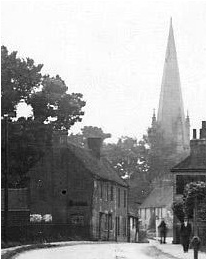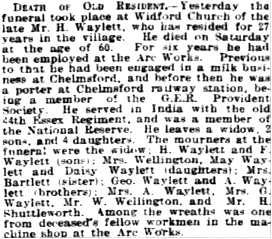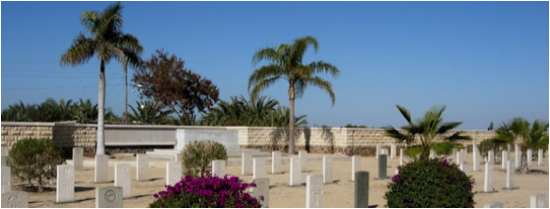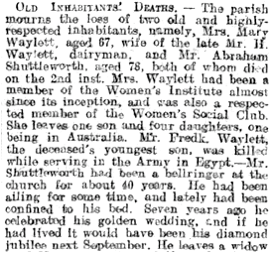Frederick Arthur Waylett was born and brought up at Widford. He worked at Crompton’s electrical engineers in Chelmsford before joining the Territorial Army before the war. Mobilized at the outbreak of war he was sent to Gallipoli, arriving there in August 1915. There, like so many soldiers, he became ill, but he recovered and was amongst those withdrawn to Egypt where fighting against the Turks continued. He died from wounds in April 1917. His home was in what is now Widford Road. A cousin also died in the war, while a nephew died in the Second World War.
Frederick was born in Widford on 11th March 1896, the son of Henry Waylett (1853-1914) and Mary Ann Waylett (nee Clift) (1854-1921). His parents had married at St. Mary’s Church in Widford on 5th October 1878. At the time both had been resident at Widford. In 1881 the family had been living in Victoria Place (now Victoria Crescent) in Chelmsford; by 1891 they were living in Widford.
On 26th April 1896 Frederick was baptised at St. Mary’s Church in Widford. At the time his father was a milkman living in Widford. He had previously served in the army in the 2nd Battalion of the Essex Regiment.
Frederick’s siblings were Annie Waylett (born in 1879), Ellen Waylett (born 1881), Lucy Waylett (1883-1883). Amy Waylet (1885-1887), May Waylett (born 1887), Harry Waylett (1890-1947), and Daisy Waylett (born 1892).
In 1901 the census found five year-old Frederick living with his parents and three elder siblings in a cottage on the south side of what is now Widford Road, Chelmsford (then known as Widford End) - the cottage stood opposite the Widford village shop and adjacent to the blacksmith’s. At the time Frederick’s father was a self-employed dairyman with his premises nearby behind the Sir Evelyn Wood public house and a business established around 1884. Six month’s before the 1901 census Frederick’s father and brother Henry had been fined 7s. 6d. and 7s. 3d. for selling watered-down milk.
WAYLETT, FREDERICK ARTHUR*,
Private, 1/5th Battalion, Essex Regiment
They have been fighting our battles, and we have been remembering and shall remember then in outs prayers. We hope that it means something to them to know that besides at our ordinary services, as we plead the sacrifice of the Cross, we mention them by name.”
The following month the Widford Parish Magazine reported that Frederick was in hospital in Malta. F Coleman and F Porter were both recovering in London hospitals.
Following its withdrawal from Gallipoli the 1/5th Battalion of the Essex Regiment landed in Alexandria, Egypt on 17th December 1915. On 28th December 1915 it was sent to El Hamam, Egypt where it formed part of the Western Frontier Force. On 5th March 1916 the battalion left for Mena Camp near Cairo, Egypt, before it was moved eastwards to protect the Suez Canal and its vital supply route, in an area known as the Southern Canal Section, from Turkish attacks across the Sinai Peninsula. The battalion remained there until January 1917.
On 4th April 1917 Frederick died from wounds sustained fighting the Turks in Egypt.
Today he lies in Kantara War Memorial Cemetery (grave: C.49), some 160 kilometres north-east of Cairo. In the early part of the First World War, Kantara was an important point in the defence of Suez against Turkish attacks and marked the starting point of the new railway east towards Sinai and Palestine, begun in January 1916. Kantara developed into a major base and hospital centre and the cemetery was begun in February 1916 for burials from the various hospitals, continuing in use until late 1920. After the Armistice, the cemetery was more than doubled in size when graves were brought in from other cemeteries and desert battlefields, notably those at Rumani, Qatia, El Arish and Rafa.
Frederick is not commemorated by the Chelmsford War Memorial, but is by that at St. Mary’s Church in Widford.
In May 1917 the Widford Parish Magazine reported:
“To Mrs Waylett has come the sad news of the death of Private Frederick Waylett; he is reported as 'died of wounds' on April 4th. Being a member of the Territorials he had served on active service since the beginning of the war. His regiment has been far away from England, so that since it went abroad we have not seen this dear boy home on leave, a matter of about two years'.
He has been called upon to make the supreme sacrifice, and we, who have seen him grow up from childhood, lament his loss, but we are proud of his achievement for bios country. To Mrs. Waylett and family we offer ours heartfelt sympathy.”
Frederick’s only brother, Harry, who was part of the original British Expeditionary Force, had been wounded on 13th September 1914 by shrapnel while serving with the 2nd Battalion of the Essex Regiment and was subsequently invalided out of the army. At the time of Frederick’s death Harry was assistant master at Chelmsford Workhouse (later St. John’s Hospital, Chelmsford). Harry’s son, Douglas Harry Waylett, was killed during the Second World War.
Frederick’s cousin, Frank Waylett Bartlett, served during the First World War with the 3rd Battalion of the Royal Sussex Regiment. While in France he was shot in the leg and his arm was shattered. He was treated at Hammersmith Hospital for some weeks and it was then found necessary to amputate the arm. Septic poisoning, however, set in with fatal results and Frank died in London on 16th June 1915. Three days later he was buried at St. Mary’s Church, Widford, but due to an administrative mix-up he was not afforded the full military funeral he was entitled to.
In October 1917 the Widford Parish Magazine reported:
“Robert Pryor writes from Egypt that in his walks around, he came across the grave of Frederick Waylett, in a desert cemetery, which was very nicely kept.”
Six months later the same magazine reported:
“Lance-Corporal Oliver Bewers writes, that he has recovered from the effects of his wound, and is once more in the fighting line. He has seen the grave of Private Fred. Waylett. A little wooden cross stands at the head of the grave which is kept in excellent order.”

A decade later, the 1911 census recorded 15 year-old Frederick with his mother and sister Daisy in the same cottage. Frederick was an armature winder at Crompton’s Arc Works (electrical engineers) based in Writtle Road, Chelmsford. On the night of the census Frederick’s father was a night watchman at that factory. At that date the boundary between Chelmsford and Widford ran down the middle of the street outside Frederick’s home (it is one of the three in the picture on the left-hand side of the road) - Frederick’s cottage was in Chelmsford, the properties opposite were in Widford.
Frederick was a Boy Scout and member of the choir at St Mary’s Church, Widford. His father died, aged 60 in the months before the war and was buried at St. Mary’s Church, Widford on 4th June 1914.
Prior to the First World War Frederick enlisted at Chelmsford into the 1/5th Battalion of the Essex Regiment, where he served as Private 250104. The battalion was a Territorial unit formed in 1908 with its headquarters in Market Road,

Chelmsford, and it consequently contained many Chelmsford men who were to lose their lives in the war. The term ‘territorial’ indicated that the volunteers such as Edward who served with the battalion were under no obligation to serve overseas, with their focus on home defence, but many like him agreed to serve abroad after the declaration of war on 4th August 1914.
At the outbreak of the war Frederick’s battalion and the other three Territorial battalions that formed the Essex Brigade were half way through their fortnight’s annual training at Clacton. On 3rd August 1914, the day before war was declared, Frederick’s battalion was initially ordered back to Chelmsford, but that was countermanded and the battalion marched for Dovercourt that afternoon. The following day mobilization papers were issued to all ranks and the battalion was
allotted part of a pre-arranged defensive line west of Dovercourt.
On 9th August 1914 the battalion was sent to Brentwood. It did not stay there long, moving to north-east Norfolk by the end of the month. In April 1915 it moved to West Bergholt, before transferring to St. Alban’s in Hertfordshire the middle of the following month. By then the battalion, along with three other Essex Territorial battalions, including the 1/4th Battalion of the Essex Regiment, formed the 161st (Essex) Brigade in the 54th (East Anglian) Division. The majority of the period since the outbreak of the war had been spent training in expectation of foreign service.
From St. Alban’s the battalion travelled to Devonport by train, and departed on board the S.S. Grampian on 23rd July 1915, with a somewhat depleted strength of 29 officers and 649 other ranks, probably including Frederick. Its ultimate destination was to be Gallipoli, Turkey to join the Allied forces participating in the campaign against the Turks which had started on 25th April 1915.
Stops were made at Malta and Alexandria in Egypt, before sailing to Mudros Bay on the small Greek island of Lemnos. From there the battalion sailed towards Gallipoli, transferred to flat-bottomed boats and were put ashore at A Beach, Suvla Bay on 9th August 1915 as reinforcements to troops that had landed there over the previous three days.
The battalion had a difficult time in Gallipoli, making little progress against the Turkish Army. With the failure of the Gallipoli campaign it was withdrawn from Anzac Cove on 4th December 1915; its strength reduced by then to 13 officers and 141 other ranks, of whom six officers and 100 other ranks had served throughout the 17 weeks in Gallipoli. Frederick suffered dysentery - in November 1915 the Widford Parish Magazine reported that Frederick and three other Widford men had been taken ill in Gallipoli:
“News has reached us of the illness of four of our Widford young men at the Dardanelles - F Coleman, F Waylett, F Porter, and H Usher. The mothers of F Coleman and F Porter have visited their sons in hospital and I can imagine some of their feelings on both sides. these men have had such experiences during the short time they have been out of England.


Frederick’s mother died in Widford in 1921, the same years she saw her son’s name on the newly completed Widford war memorial.
140130